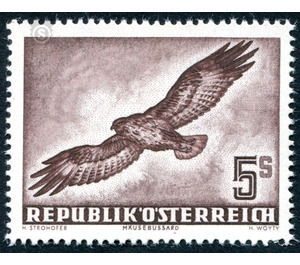birds - Austria / II. Republic of Austria 1953 - 5 Shilling
Theme: Animals
| Country | Austria / II. Republic of Austria |
| Issue Date | 1953 |
| Face Value | 5.00 |
| Edition Issued | 350,000 |
| Color | brown |
| Printing Type | Typography |
| Stamp Type | Air Post |
| Item Type | Stamp |
| Chronological Issue Number | 329 |
| Chronological Chapter | OOS-OE2 |
| SID | 797646 |
| In 31 Wishlists | |
2. Air mail series "Vogelflug" - buzzard There was no need for an air mail series, but the post office wanted to follow the tradition of the prewar period, when a series of airline stamps had appeared simultaneously (eg 1925 and 1935). The designer Prof. Hans Strohofer consciously dispensed with the then customary framing of the brand image in his designs to indicate the vastness and "boundlessness" of the sky. 29.9.1953: 5. Value 5S: Common buzzard The Buzzard is a bird of prey from the hawk-like family and the most common member of this family in Central Europe. It is medium in size and compact, the plumage varies from dark brown to almost white. He can often be observed during his circular gliding or during the Ansitzjagd. Its habitat is open landscapes such as meadows, fields, wetlands, or short vegetation by humans. Often, buzzards are seen sitting on posts along highways as they search these and other trails while hunting. When selecting a nesting place, forest edges of smaller stocks of old wood are preferred. 6 April 1956: The end of the airmail stamps: With instructions from the General Postdirektion, all airmail stamps were declared postage stamps and released at franking for all postal items. The fact that Austrian Airmail stamps were in the past only permitted for the franking of air mail items had occasionally given rise to errors. Balloon mail was NOT considered an airmail: When the first balloon mail was granted to the Austrian Children's Village Association in 1948, Austria was not allowed by the allied victorious powers to operate an airmail in its independent sphere of influence. However, in order to be able to set up the balloon post at all, the PT established that this mailing was not an airmail, because the authorization of the Allied occupying powers would have had to be obtained for this purpose. The balloon mail was therefore declared to interest post offices, whereby it was left to the organizers, with which means of transport the mail was carried. A parallel case to these balloon items was the Segelflugpost 1950 from Graz on the occasion of the jubilee exhibition "100 Years Stamp". Consequently, the use of airmail stamps for these mailing operations was also inadmissible, except in the case of airmail being forwarded. The airmail surcharge was credited to the country, whose aircraft then transported the post. The only exception was the 4th balloon mail on 21.10.1950, which was also the first day of the first beisen Airmail stamps of this series (60 g and 2.-S), as by an "erroneous interpretation" of the then new provisions also for the domestic addressed balloon mail items airmail stamps were accepted for franking. This was immediately banned by a separate disposition for all subsequent events.


